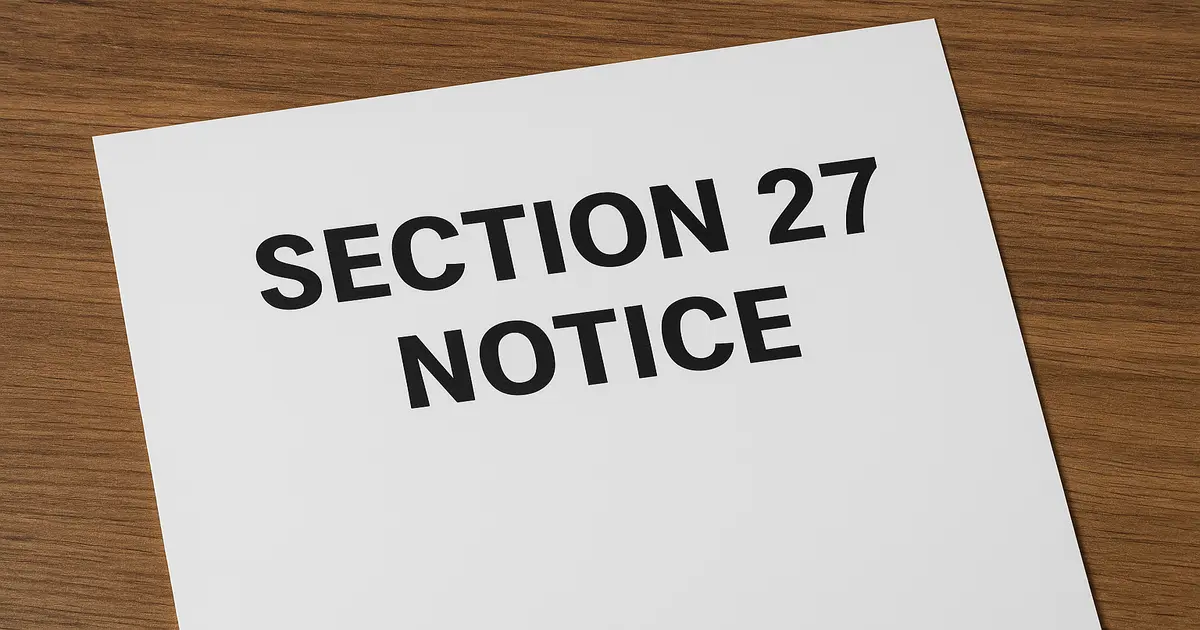What Is a Section 27 Notice and How It Works for Commercial Property in England and Wales
A Section 27 notice under the Landlord and Tenant Act 1954 is a legal mechanism that allows a tenant of commercial premises to terminate their lease at the end of the contractual term.
Understanding how a Section 27 notice works is crucial for both landlords and tenants to ensure a smooth transition at the end of a lease and to avoid unintentional lease renewals.
In this article, we explain what a Section 27 notice is, how and when it should be used, and the legal implications for tenants and landlords in England and Wales.
What Is a Section 27 Notice?
A Section 27 notice is a formal notice served by a tenant to inform the landlord of their intention to leave the commercial property at the end of the lease term.
It is part of the statutory termination procedures under the Landlord and Tenant Act 1954, which governs most business tenancies in England and Wales.
This notice allows tenants to prevent the automatic renewal of a business tenancy under the security of tenure provisions granted by the 1954 Act.
When Is a Section 27 Notice Required?
A Section 27 notice is typically required in the following scenarios:
- The lease falls within the Landlord and Tenant Act 1954 (i.e., not excluded from security of tenure).
- The tenant does not wish to renew the lease.
- The contractual term is due to expire, and the tenant wishes to vacate without further obligation.
If a tenant does not serve a Section 27 notice, and no notice is served by the landlord either, the tenancy may continue automatically as a periodic tenancy, which can complicate the legal position and lead to unintended liabilities.
Types of Section 27 Notice
There are two types of Section 27 notices under the 1954 Act:
Section 27(1) Notice
- Applies before the contractual expiry date of the lease.
- Tenant must serve at least three months’ notice.
- Used when the tenant wants to terminate the lease before the contractual term ends.
Important: This only applies if the tenant is still within the contractual term and wants to terminate early (if allowed under the lease terms).
Section 27(2) Notice
- This applies after the contractual term has ended, and the tenant is holding over under the 1954 Act.
- Must be served at least three months before the tenant intends to vacate.
- Cannot be served if the tenant has already requested a lease renewal under Section 26.
This is the most commonly used notice for tenants vacating at the end of the lease.
Key Legal Requirements
To be valid, a Section 27 notice must:
- Be in writing.
- Be served on the landlord in accordance with the lease terms or statutory service requirements.
- Give at least three months’ notice.
- Specify the date of termination (must be after the contractual expiry of the lease for Section 27(2)).
How to Serve a Section 27 Notice
Service of the notice is critical. It must be:
- Delivered to the landlord’s registered address or the address specified in the lease.
- Sent via recorded delivery, hand-delivery, or other provable method.
- Dated correctly and clearly state the intention to vacate and the relevant legal section (i.e., 27(1) or 27(2)).
Failure to serve properly could result in the tenant remaining liable for rent or the tenancy continuing under statutory provisions.
Landlord’s Position After Receiving a Section 27 Notice
Once the landlord receives a valid Section 27 notice:
- The tenant’s statutory protection ends on the termination date.
- The landlord can re-let or redevelop the premises without further notice to the tenant.
- If the tenant fails to vacate, the landlord may need to start possession proceedings.
Can a Section 27 Notice Be Withdrawn?
A Section 27 notice cannot be unilaterally withdrawn once served. If the tenant changes their mind, the landlord must agree in writing to disregard the notice and continue or renew the lease.
Useful external links for further reading on Section 27 notices for commercial property in England and Wales:
UK Government – Landlord and Tenant Act 1954 (Full Legislation)
RICS – Ending a Commercial Lease
Pinsent Masons – Practical Law Guide: Ending a Business Tenancy
The British Landlords Association is a national landlords association for UK landlords. It is one of the largest landlord associations in the UK. Join us now for £79.95!
Our top read blogs:
Understanding Commercial Property EICR Requirements in the UK
How to deal with Commercial Property Dilapidations UK
Is Commercial Property a Good Investment in England & Wales?

Disclaimer:
This post is for general use only and is not intended to offer legal, tax, or investment advice; it may be out of date, incorrect, or maybe a guest post. You are required to seek legal advice from a solicitor before acting on anything written hereinabove.





